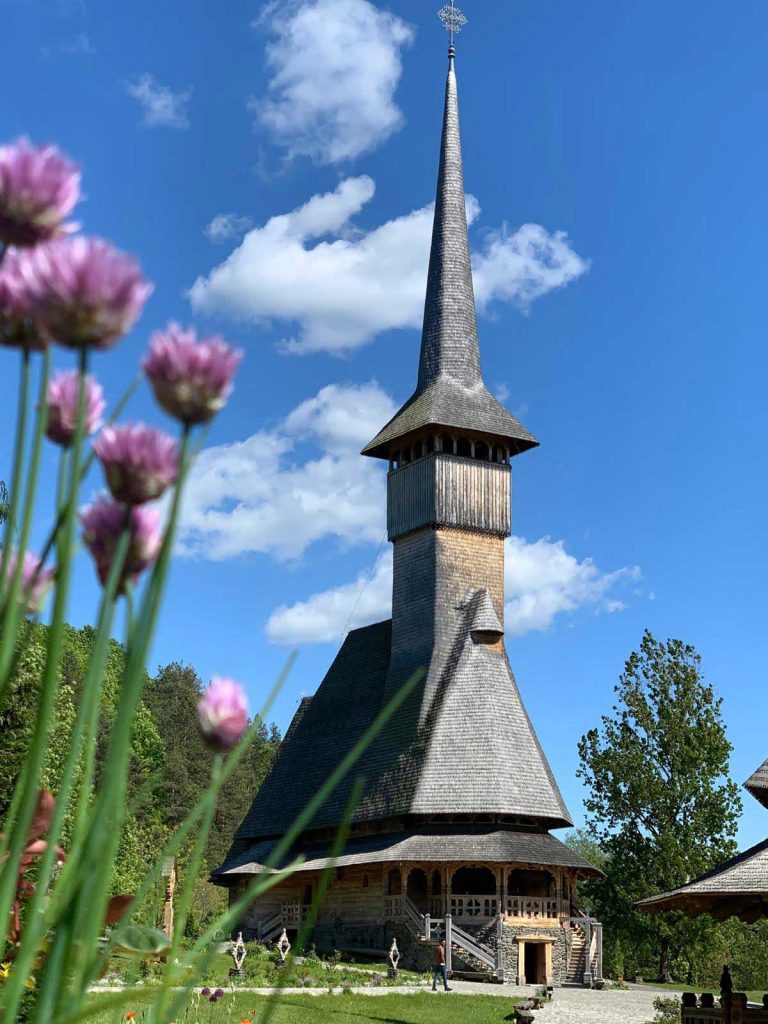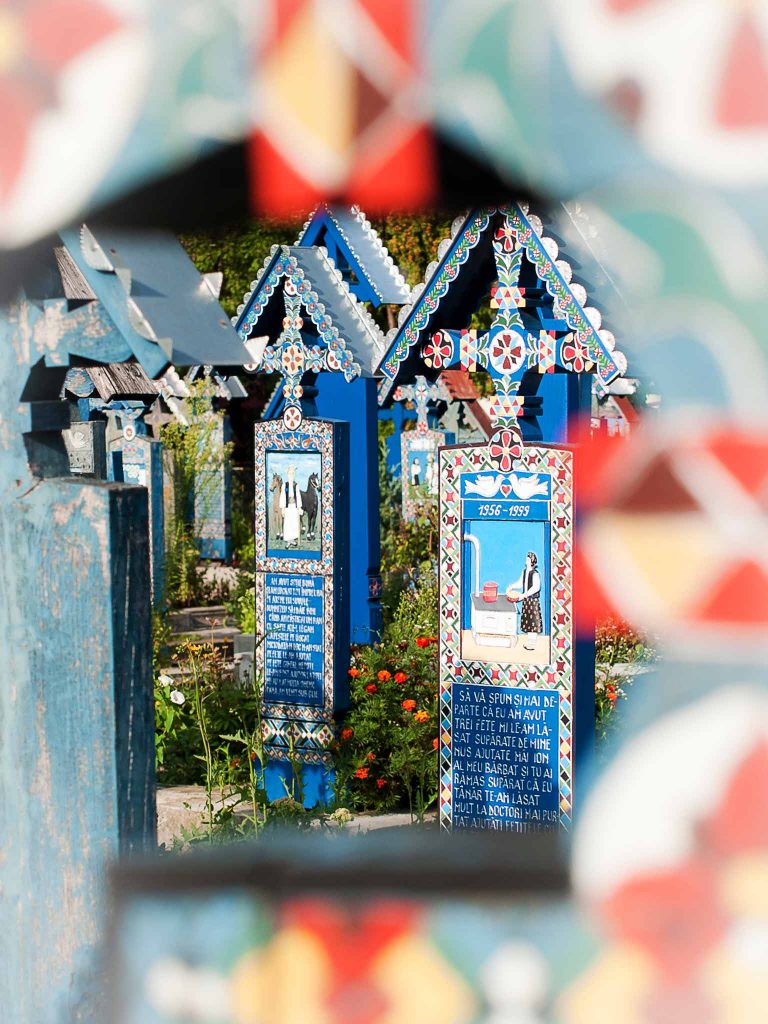Today we are traveling to a monastic realm in the land of Maramureș, where we will discover the natural beauty of the region as well as its rich cultural heritage, represented by the charming wooden churches.

Cluj Napoca
9:00 AM
We will start this day in a remote village, far from the hustle and bustle of urban life, in Budești, a place that hides a beautiful wooden church listed as a UNESCO World Heritage site. Located on a small hill, impressive with its tall spire that seems to pierce the sky, this is the largest wooden church in historic Maramureș. The building is remarkable for its technique of joining wood in the construction process, its interior frescoes, and the wooden icons that dominate the interior. The church preserves part of the armor of Pintea Viteazul, the legendary outlaw of Maramureș, who left his chainmail and helmet in the care of the church after the battle against the Tatars in 1717.
In Sârbi, a small and isolated village with old homesteads that seem straight out of fairy tales, we are drawn to the corn mill by the roadside and the famous Maramureșan water mill near the river, used for washing carpets. We will stop for a moment to explore the traditional technical installations and chat with the ‘craftsman’ who maintains them.
We will continue our journey with a visit to a monastic complex in the commune of Bârsana, a collection of wooden buildings created by local craftsmen, set in a picturesque natural setting on the Iza Valley. Here in Bârsana, we are greeted from the entrance by a wooden church with a majestic arch that opens like a gateway to a piece of paradise. We are about to step into another spiritual realm. The wooden church with its roof piercing the infinite sky is the centerpiece of this complex, built on a foundation of hard stone, reaching up towards Divinity. Tranquility characterizes the area, making it an ideal place for reflection and spiritual upliftment. We will walk along the narrow paths in the garden with colorful flowers and inviting fragrances and admire the wooden structures here (the Summer Altar, the Artist’s House, the Bell Tower, the Monastery Museum, the Craftsmen’s House), true treasures of Maramureșan sculptural art. A place of pilgrimage, a destination of attraction due to the wooden church and Maramureșan gates, a sacred place where the Church harmonizes perfectly with the rural backdrop.

We will descend slowly along the Iza Valley and continue our journey to Ieud, where we will visit another representative church from the region’s collection of religious sites. The Ieud Deal Church, named after its location on the village hill, is the oldest wooden church in the country and is included in the UNESCO World Heritage list. Its construction on the top of a hill originates from an old belief of the locals, who thought that their prayers would reach divinity more quickly if the place of worship was as close to the sky as possible. The church is noted for its well-preserved interior murals, in serene tones.
After a day filled with spirituality, we return to the guesthouse with beautiful and valuable experiences in our memory. Accommodation and dinner at the guesthouse.
Don’t miss the Monastery Museum in Bârsana, which houses old, typically Maramureșan icons, locally inspired furniture, and a rich collection of local folk art. Discover the small workshops where the nuns perfect the art of weaving and icon painting on the ground floor. It’s also worth visiting the Artists’ House to see up close the work of the artists, where icons are painted and various construction maintenance tasks are carried out.
After a well-deserved rest in the tranquil Maramureșan landscape, we begin today’s journey with renewed energy, heading to the far northern part of Maramureș, to Săpânța, a village situated on the left bank of the Tisza River, near the northern border between Romania and Ukraine. On our way, we will dedicate a few minutes to visiting a representative church in Maramureș, the Greek-Catholic church of Surdești, known as the tallest wooden church in the world and included in the UNESCO World Heritage list. Hidden from travelers’ view among valleys and winding paths, we can discern the church’s towering spire from afar, impressively measuring 72 meters in height. The church is notable for its well-preserved frescoes on the interior walls, its Maramureșan decor that attracts the eye from the moment of entry, and its blend of architectural elements—a fusion of Gothic and Byzantine forms, rendered in a unique interpretation by local craftsmen.
We then proceed along winding roads and cross the Gutâi Mountains to reach the northern part of Maramureș, Săpânța, renowned for its famous Merry Cemetery. The Săpânța Cemetery is ranked first in Europe and second in the world, after the Valley of the Kings in Egypt, for its uniqueness, impressing visitors with its vibrant colors and the stories carved into the wooden crosses. The story began in 1936 when the village craftsman, Stan Ioan Pătraș, had an idea to give death a cheerful face and honor the memory of each local in a unique and positive way. Here, in Săpânța, the crosses do not just mark graves but speak in words and convey humorous messages that describe the lives of the locals. Legend has it that the serene attitude towards death is a Dacian custom, who believed in eternal life, viewing death merely as a transition to another world. The most amusing messages are engraved and colored on the marked and numbered crosses inside the cemetery, with the legendary one being the ‘Mother-in-Law’s Cross’. Because we appreciate how the people of Maramureș view death and their passion for turning simple grave crosses into folk art monuments, we will attempt to uncover the stories of the lives of those who rest here.

We continue our Maramureșan journey with a visit to the city of Sighet, known for the Museum of the Victims of Communism and of the Resistance. This museum, set up in the former political prison, serves as a form of reviving collective memory, as intended by its creators. The museum allows visitors to explore cells where renowned political figures (including Iuliu Maniu), journalists, intellectuals, and students who opposed the communist regime were imprisoned. It represents a dark chapter in the country’s history, but one that must not be forgotten.
We end the day with a relaxing stroll in a fairytale setting at the Maramureș Village Museum, an open-air museum where we can see wooden houses and homesteads from the main areas of Maramureș. We will admire the famous Maramureșan wooden gates, wooden churches, and typical homestead buildings like the well with a scoop, animal enclosures, and various objects and tools.
Return to the guesthouse for a traditional dinner.
Don’t miss the House of Master Stan Ioan Pătraș, now a Museum and Workshop where crosses are crafted and restored by his apprentice, who continues the craft.
Because no visit to the remote land of Maramureș would be complete without a ride on the famous Mocănița through the Vaser Valley, in the heart of historic Maramureș, we invite you to board the carriages and traverse a wild, forested area where there are no access roads and wildlife roams freely.

Originally used for transporting timber from the Maramureș Mountains, the Mocănița now winds its way along a serpentine path through the virgin forests of the Vaser Valley, inviting us to admire fairytale landscapes with scattered cottages on the hills and thrilling us with every whistle of the locomotive. We will make a brief stop at Paltin for a culinary surprise, delighting our taste buds with local delicacies and taking some time to explore the nearby glade. Returning to the carriages, we will weave through enchanting landscapes, breathe in the crisp mountain air, and watch the steam of the locomotive evaporate among the hills one last time.
Accommodation and dinner at the guesthouse.
